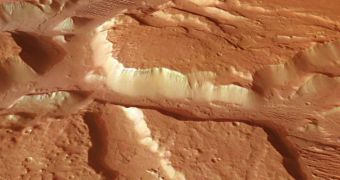Mars Express sent back some interesting pictures of the Aeolis Mensae region on Mars, lying on a tectonic transition zone. The High Resolution Stereo Camera (HRSC) on board the space probe took snapshots of the wind-eroded features, like incised valleys and unexplained linear features.
This region on the surface of Mars is characterized by the lack of surface flow paths, boulder-free slopes, multiple layers and abrupt steepening of valley longitudinal profiles, developed in a sedimentary deposit.
It's a 841 km wide flat-topped elevation that has been photographed with a ground resolution of 13 meters per pixel, so the pictures clearly present the morphology of the terrain, a transition zone separating the southern highlands and northern lowlands.
The average difference in elevation between the highlands and the plains is of about 3,000 meters and its origins are still a subject of debate. The highlands are crossed by 2,500-meter-deep valleys, to the North and show linear features on the floor of the valley that may have been created by glacial processes, much like similar glacial grooves on Earth.
A new study of the pictures contradicts the glacial origins, because of the fact that these features are orthogonal to the elongation of the valley, so the real cause of these valleys could be erosion caused by the wind.
Wind-related activity on the surface of the planet may be responsible for the large number of "yardangs," long, irregular ridges with sharp crests that lie between two round-bottomed troughs carved out by wind erosion in an arid region.
The almost linear features have probably been shaped by the action of sand material being blown by winds, that in time eroded the weaker material, producing crevasses spanning for several hundred meters from southeast to northwest, in the direction of the winds.
Similar structures have been found in deserts on Earth, where winds are the main agent of change for the landscape, in the absence of water.

 14 DAY TRIAL //
14 DAY TRIAL //